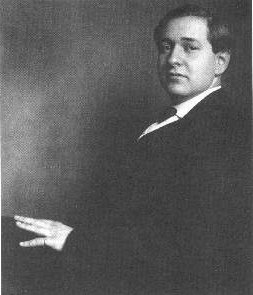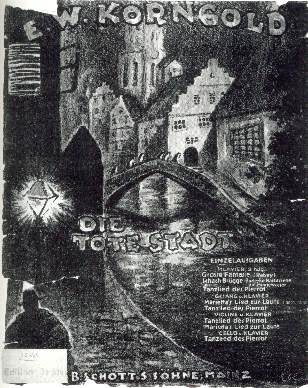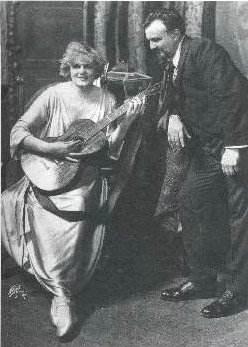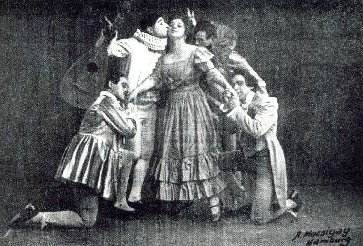Introduction
I will nail my colours to the mast immediately and
admit that I abhor clever, clever modern versions of operas that destroy
the spirit and intent of their original productions. The latest to incur
my wrath is this ARTHAUS production of Korngold’s Die tote Stadt
(The Dead City). Since this work is of great interest to visitors of
both MusicWeb and its sister site Film Music on the Web, I am including
contrasting reviews of both this DVD and the acclaimed 1975 RCA Erich
Leinsdorf world premiere audio recording to demonstrate the difference,
for this reviewer anyway, between the sublime and the ridiculous.
[Granted the original book, on which Die tote Stadt
was based, was colder and more horrific without the life-affirming ending
of Korngold’s opera. This might explain not only the Opéra National
du Rhin’s relentlessly down-beat and more brutal production but also
the concept behind other more recent ‘creative’ productions. One (Götz
Friedrich in Berlin) had Paul interpreted as a possible serial killer
with overtones of sado-masochism and in an American production, Marie
and Marietta respectively resembled Kim Basinger and Marilyn Monroe!
-- More on the Hollywood connection (and Marilyn) follows throughout
this article/review]
Background to the Opera and connections with
Wagner, Bernard Herrmann and Alfred Hitchcock’s Vertigo
 Korngold 1919
Korngold 1919
Die tote Stadt was the most successful of Korngold’s
operas – an amazing achievement for a young man still not twenty when
he began its composition. It was simultaneously premiered in Hamburg
and Cologne on 4th December 1920. The premiere in Hamburg
was a sensation and it became one of the most popular operas in the
Hamburg repertory with well over fifty performances; in fact it was
one of the most frequently performed of all contemporary operas. It
appeared on more than 70 stages in Europe and America. ‘Marietta’s Lute
Song’ and the ‘Pierrotlied’ became smash hits and favourite encores
in their own right.
Die tote Stadt began life as a horror story,
a novella Bruges-la-Morte by the Belgian symbolist writer Georges
Rodenbach – a sort of free variation on the Celtic-derived myth Tristan
und Isolde.
[One might conjecture whether this story influenced
Pierre Boileau and Thomas Narcejac in writing their novel D’Entre
les Morts on which Alfred Hitchcock based his celebrated thriller
Vertigo? The plot line of Vertigo shares many similarities
with that of Die tote Stadt. In fact Bernard Herrmann’s celebrated
score for this film, that has consistently entered the lists of best
film of all time, has been observed to reflect Wagner’s Tristan…
music, specifically the ‘Liebestod’ in Herrmann’s ‘Scène d’Amour’,
in which the hapless Judy Barton (Kim Novak) is made over by Scottie
(James Stewart) to look like his dead love, Madeleine. And Korngold’s
score for Die tote Stadt employs the Wagnerian leitmotif style
and there is more than a passing resemblance to Tristan… More
on this theme later.]

"This cover illustration of the Schott publication
of excerpts from Die tote Stadt, arranged for piano duet, depicts
very well the sort of atmosphere which Korngold sought to portray the
medieval city of Bruges with its dark streets, canals, processing nuns
and tolling church bells."
The story of Die tote Stadt is set in the ancient
Belgian town of Bruges, a dead-seeming city whose bells, still canal
waters, gloomy gothic churches and old decaying houses are for Paul,
the hero, constant reminders of death and impermanence. They are, for
him, the symbol of his saintly dead wife Marie, and the past that he
cannot forget. One room of his house has become a precious shrine to
her memory in which he preserves furniture, photographs and a lute and
above all a portrait of Marie and a braid of her golden hair. Paul lives
alone save for his devoted housekeeper, Brigitta. Then, one day he meets
a woman in the street. Her striking resemblance to his dead wife causes
him to be overcome with strong conflicting emotions. He impulsively
invites her home so that he might see the dead come to life…
Korngold uses a huge orchestra – the largest he ever
used with much exotic percussion, piano, celesta, church organ and a
harmonium for eerie effects, a wind machine, mandolin, sets of bells,
and stage bands as well as a large chorus, separate children’s chorus,
a chamber choir of 16 voices and eight additional female voices off-stage.
The music is approachable and melodic. Indeed in the context of his
operas, Korngold was dubbed the ‘Viennese Puccini’. The leading vocal
parts, Paul and Marie/Marietta, are extremely demanding.
The 1975 RCA CD Leinsdorf/ Munich Radio Chorus
and Orchestra review
From the brief opening opulent, exuberant orchestral
peroration, it is at once apparent that Leinsdorf is conducting large
forces in this 1975 RCA Victor recording. Alas, and this is a major
disappointment and serious omission, the accompanying booklet carries
just the story of the opera and the libretto in German and English.
There are no notes about the history and production of the opera or
about Korngold’s huge score. At that time this was particularly galling
since there was very little Korngold documentation available. Luckily
now, since the Korngold centenary year, 1997, two important new books
on Korngold by Jessica Duchen and Brendan G.Carroll have been published
that include a lot of detail about Die tote Stadt (see footnote
to this article/review for full details about these two publications).
We first meet Brigitta, Paul’s housekeeper (mezzo-soprano
Rose Wagemann) loyal and caring in her lovely, warm-hearted, supportive
aria ‘Was das leben ist weiss ich nicht…’ in which she extols "And
where love is, a woman like me can serve contented…" She is in
the room that is Paul’s temple to Marie with Paul’s friend Frank (baritone
Benjamin Luxon in fine voice recorded without any trace of the excessive
vibrato that spoiled so many of his later performances). Paul bursts
in, in great excitement after seeing Marietta who so resembles his deceased
wife Marie. In his first aria, ‘Nein, nein, sie lebt’, Paul reveals
his obsession with the dead Marie and his belief that she now lives
again in Marietta. At first exultant, then romantically yet morbidly
reflective this aria is a tour-de-force with Korngold’s brilliant
harmonies and eerie atmospheric orchestrations. René Kollo, so
brilliant in the role of Walther in the 1971 Karajan recording of Die
Meistersinger von Nürnberg, here again impresses with his ringing
ardent tones and sensitive musicianship. His Paul is a rounded character
defiant and manly as well as obsessive.
Frank, concerned for his friend’s welfare, offers a
warning and sensible advice in his expansive aria, "…Paul, you
are playing a dangerous game. You are a dreamer. You see ghosts and
phantoms – I see reality, I see women as they are…". But Paul will
not listen and Frank exits. Frank is right: Marietta is quite unlike
Marie. She is worldly and fun-loving. Korngold’s wonderfully rapt music
rises from the orchestra as Paul awaits her arrival in ever mounting
anticipation. But Marietta is annoyed by his apparent distraction -
she cannot comprehend Paul’s introspection and persistent dreaming of
Marie. Carol Neblett’s Marietta is exuberant and carefree as she says
she lives to sing and dance. The orchestral accompaniment switches between
the eerie ghostly world of Paul’s psyche and the lighter atmosphere
of Marietta’s worldly outlook. When Paul shows her the lute that Marie
played she sings the beautiful Lute Song ("Joy, sent from above…")
that was the hit of the opera from the very first. The Kollo and Neblett
duet that is a continuance of that aria is heart-rending indeed and
again the orchestration scintillates.
Marietta demonstrates her flirty nature and goes off
with her theatrical troupe friends with a lingering promise to the distracted
Paul "Those who love me know where to find me. And they can see
me dance at the opera." Act I ends as the opera’s action shifts
from reality to the beginning of Paul’s hallucinatory visions. The ghost
of Marie steps out of the picture (to eerily evocative music) to tell
Paul that he is with her forever, that her braid of hair will guard
him but that "Life comes to claim you, a new love beckons…".
The apparition disappears and is replaced by another of Marietta in
a hedonistic dance. Paul is ecstatic
.  "
"
Maria Jeritza as Marietta and Orville Harrold as Paul
pictured during the dress rehearsal of the 1921 New York Metropolitan
Opera production of Die tote Stadt. Jeritza carries a guitar
that stood in for a lute (Metropolitan Opera Archives)."
Act II is a continuation of Paul’s fevered dreaming.
He wonders disconsolately by a canal close to Marietta’s house. In an
extended orchestral interlude with brilliant orchestral effects (organ
and wind machine included): huge bells toll and an oppressive gothic
atmosphere hangs over all. The Bavarian players here, as they are throughout,
are superb and the sound engineering stunning. Paul in another extended
aria berates himself for prowling about after Marietta and "tasting
bitter pleasures". He recalls purer, more innocent times. Brigitta,
passing by, admonishes Paul for desecrating the memory of Marie and
goes off to church. Frank appears and berates Paul too saying, "You
are not right for her, you’re sharing death and life with her. She wants
complete fulfilment. We are Harlequins who adore her and she is Columbine
who seduces us and enslaves us." Paul’s jealousy is aroused when
he realises that Frank has succumbed to Marietta’s charms too and declares
that Frank is no longer his friend.
Marietta then approaches with her friends. They are
in boats on the canal. They flirt and sing waltz songs. One admirer
who Marietta has cast aside, Fritz, Marietta’s ‘Pierrot’, sings the
other big hit number from the opera, "Mein Sehen, mein Wähnen…"
(My dreaming, my yearning) in which he remembers young love and dancing
"by the Rhine in moon’s golden shine". Baritone, Hermann Prey,
I fear, is too solemn, too intense for this loveliest of waltz songs.
Marietta then suggests they rehearse Hélène’s
scene from Robert le Diable in the streets. The sounds of an
organ from a nearby cathedral, processing Beguine nuns and dark clouds
form an ominous background for this heavily ironic scene as Marietta,
acting as Hélène, rises from a coffin and dances seductively
towards one of her admirers. This is another powerful set piece with
horrifically evocative music from Korngold’s huge orchestra. Scandalised
and outraged, Paul rushes from out of the shadows to curse Marietta
and her friends. "You, a resurrected woman? Never?" Abashed
and embarrassed, Marietta’s friends depart but Paul continues to hurl
accusations at her and in doing so he reveals his suppressed emotions.
Marietta is deeply hurt but decides to take up the struggle against
her dead rival. She musters all her powers of persuasion and overcomes
his protestations. But when he suggests they go to her house she replies
"No, to yours, to her house". There she wishes to banish the
ghost of Marie forever… The act concludes with another dramatic love
duet.
Another ravishingly orchestrated Prelude opens Act
III that continues Paul’s hallucinations. Marietta has spent the night
with Paul in his house. In the early morning she enters Paul’s shrine
and confronts Marie’s portrait. In a bitter aria she rounds angrily
on the dead wife - "You, who are dead and buried; rest in peace
and slumber. Don’t haunt the living … leave us to revel in joy and pleasure
…" Marietta hears in the distance the purity of a children’s choir
and rejoices in their supplication a brief glimpse at another side of
Marietta’s complex personality.
Paul enters, suspicious of her presence in his ‘temple
to Marie’ and immediately puts Marietta on the defensive. She is even
more determined to dispel the ghost of Marie once and for all. Outside,
the enlarging religious procession draws closer. Paul is alarmed that
they will be seen together and pushes Marietta away from the window.
This makes her taunt him even more in a coquettish aria full of spite
in which she yearns for her carefree past with her admirers. She blasphemes
the procession outside – "You keep them, your pious masqueraders!"
The procession is right outside now and there is a tumultuous choral
and orchestral climax with Paul commenting wondrously on the holy statues
and banners. Marietta acquiesces to his mood and begs him to kiss her.
Paul shocked draws back. "Not here, not now". "Yes here,
now", she demands. Their subsequent quarrel becomes ever more heated
(both chewing the scenery over vicious orchestral chords) and in the
end Paul strangles Marietta with Marie’s braid of hair.
The stage darkens. Paul awakens from his dream. Brigitta
enters to say that the real life Marietta has returned. She finds Paul
silent and stunned by his dream. Thinking he is uninterested – she shrugs
and goes away. Frank enters, notices Marietta’s departure and sees that
the young dancer no longer fascinates Paul. This is the miracle he had
wished for his friend. Paul agrees that he will never see Marietta again
and that his nightmare had destroyed his dream of love, "The dead
send dreams like that to haunt us if we don’t let them find peace in
their slumber," he observes. Frank plans to leave Bruges and Paul
agrees to go with him to find a new happier life. Paul’s final aria
in which he pays a final farewell to Marie "Wait for me in heaven’s
plain…" is sung to the same glorious tune as Marietta’s Lute Song
of Act I.

"A scene from the original 1920 Hamburg production
of Die tote Stadt. From left to right: Walter Diehl (Graf Albert);
Josef Degler (Fritz) Anny Münchow (Marietta); Felix Rodemund (Gaston);
and Paul Schwartz (Victorin)."
The depth of this review is intended so that a more
effective comparison can be made between this conventional production
that Korngold would have envisioned and that of the Opéra National
du Rhin as presented on the ARTHAUS DVD ---
The 2001 DVD Video Opéra National du Rhin
production review
First of all it should be recalled that Korngold is
best remembered for his Warner Bros. film scores written in the 1930s
and 40s principally for Bette Davis and Errol Flynn. This Opéra
National du Rhin production team - Charles Edwards (set design and lighting)
and Magali Gerberon (Costumes) - has clearly borne Korngold’s Hollywood/film
connection in mind. And the close similarity between the stories of
Die tote Stadt and Alfred Hitchcock’s Vertigo has not
escaped them either. These influences pervade this production which
frankly repels (although some aspects of it have a perverse fascination,
especially in the second act). In many respects it goes against the
spirit of the original production that Korngold knew and as described
in the 1975 premiere CD recording reviewed above.
The Act I set showing Paul’s shrine to the memory of
Marie is seedy and run-down. Part of the set looks as though a bomb
has hit it. The treasured portrait of Marie leans against a wall rather
than hanging in pride of place. Paul’s housekeeper Brigitta (Brigitta
Svenden) is blonde, bespectacled and buttoned up in a high-collared
oriental-style suit. She looks something between Midge (Barbara Bel
Geddes), Scottie’s erstwhile girlfriend in Vertigo and Beatrice
Lilly as the cantankerous, kidnapping landlady, Mrs Meers, in Thoroughly
Modern Milly. Svenden, in her big aria in which she assures Frank
she is happy in a house with an atmosphere of love (even dead love)
is appealing but she is a little unsteady and in danger of being swamped
by Korngold’s effulgent orchestrations.
A little later she is required to bring roses into
the temple. She brings not live flowers but rose-decorated wallpaper.
There is worse madness to come, folks.]
Frank (Yuri Batukov) is sturdy and comforting.
Paul, a heavy-jowled Torsten Kerl, wears trousers at
half mast and has long blonde tresses that make him look like some demented
Little Lord Fauntleroy. As Marietta arrives he is seen clutching a doll-effigy
of Marie. He appears in front of Marietta looking like some miserable,
self-pitying girl’s blouse -- no wonder she is non-plussed! At one point
he even makes a quivering Stan Laurel look heroic. By the time he commits
suicide at the end of the opera (yes, suicide, more about this clanger
later), one has lost all patience and sympathy for him. Kerl’s voice
is powerful enough to project above Korngold’s heaviest music but it
lacks Kollo’s attractive timbre and his expressive subtlety.
Marietta has long wide curly blonde tresses and wears
a decorated white Columbine-like dress and inelegant black footwear
calculated to rile the fashion police. Angela Denoke’s acting is very
persuasive and her bright voice projects strongly. Pity she is let down
by the stage directions. One’s jaw drops in utter horror and disbelief
at what happens next. Marie’s lute that Paul shows her is cast aside
in favour of a piano accompaniment (played by some inexplicable character
unconnected with the opera who just strolls on to the stage) as she
sings Marietta’s Lute Song. As she sings Paul writhes on the floor,
and, horror of horrors, pulls out of from a trapdoor beneath him a skeleton
arm (belonging, one guesses to Marie) and proceeds to kiss it. Clearly
the effect of this lovely aria is totally crushed but so too is Marietta’s
joyful song a little later. Here she stands over a storm grating (in
the middle of a room?) while upward air currents billow out her skirts
like those of Marilyn Monroe in The Seven Year Itch (but Monroe
played an innocent concerned only with keeping cool in a New York heat
wave). Back to Vertigo: Saul Bass’s unsettling kaleidoscopic
spiral patterns that were used for the film’s opening titles are seen
here in a huge circle projected high to the right of the stage. This
pattern blends into a close up of part of Marie’s face as her apparition
informs Paul that a new love awaits him, as Act I ends.
Act II sets are equally bizarre, but fascinating, in
keeping with Paul’s nightmare visions. The circle with Marie’s face
fades and ghostly images of Bruges take their place with figures in
medieval dress moving about the stage through the Prelude. Then a huge
bell descends and a depressed Paul tries to hang himself from its rope
but is dissuaded by passers-by. The bell lowers to the ground and turns
over so that the audience is looking deep inside its dark circle. From
inside, the image of Brigitta appears to disparage Paul. Then Frank
appears on stage with a bushy red tail, red hair and horns – now clearly
a devilish apparition. When Paul discerns that he has designs on Marietta
too he kills Frank in a radical departure from the original opera story
line. The Harlequinade that follows seems as though it is set in Las
Vegas with neon lights and brassy bars. Marietta’s friends in garish
costumes look as though they are fugitives from some Fellini film. Nuns
tear off their habits and are seen in skirts resembling the Stars and
Stripes. On the credit side, however, Fritz’s (Pierrot’s) aria sung
by a lighter voiced Stephan Genz is spellbinding and much more moving
than Hermann Prey is on the Leinsdorf CD.
Act III brings yet more visual horrors. The religious
procession, in garish costumes and ghoulish make-up, seems to emanate
from beneath the earth. Paul demonstrates his religious fervour and
guilt by clinging, in a posture just short of blasphemy, to a large
cross. This cross is tugged between an incensed Marietta and himself
who taunts him so much that he kills her not with Marie’s braid of hair
but a knife.
In this outrageous production one wonders if Paul ever
awakes from his nightmare. Frank as a ghostly apparition appears still
in his scarlet tail and horns to give him the knife which Paul uses
on himself as he sings that final aria then falls in his death throes
and blooded against a door marked NO EXIT. This ending of course runs
totally contrary to the original opera’s life-affirming ending and purpose
of Paul’s visions. It is all very sad because there is some fine singing
and Jan Latham-Koenig, although not in the same class as Leinsdorf,
delivers fine dramatic and atmospheric music from what I perceived to
be rather smaller forces than in the RCA recording.
Conclusions
First this bizarre production prompts one to wonder
how Korngold would have scored Alfred Hitchcock’s Vertigo had
he survived into the 1950s and presuming, of course, that the master
of suspense would have hired him. Not wishing to disparage Bernard Herrmann’s
excellent score in any way, my guess is that the story would have fascinated
Korngold and that he would not have been able to resist it. I think
he would have brought a deeper insight into the predicaments of the
characters of Scottie and Madeline/Judy Barton.
But to a final assessment of the two recordings.
The RCA premiere recording released in 1975 is unhesitatingly
recommended. The lead roles (René Kollo and Carol Neblett) are
sung with passion and conviction and the expanded Munich Radio Orchestra,
recorded in spectacular sound, sounds magnificently opulent.
The new Arthaus DVD is, in comparison, weighed down
with ridiculous, garish sets, costumes and effects (although there is
no denying that sometimes they have a powerful fascination). Angela
Denoke shines as Marietta/Marie despite everything that happens around
her, and there is a memorable cameo from Stephan Benz as Fritz the Pierrot
in one of the opera’s great hit numbers. But Torsten Kerl cannot match
René Kollo in voice and his gross over-acting disappoints.
If you must watch the DVD just hire it from a library
and buy the Leinsdorf recording to treasure.
Ian Lace
Footnote
Further details about Die tote Stadt and the life and music of
Erich Wolfgang Korngold may be found in the following two books:
The Last Prodigy – A biography
of Erich Wolfgang Korngold
By Brendan G. Carroll
Published by Amadeus Press ISBN I–57467–029–8
Erich Wolfgang Korngold
By Jessica Duchen
Published in Phaidon Press’s 20th Century Composers series
ISBN 0-7148-3155-7

